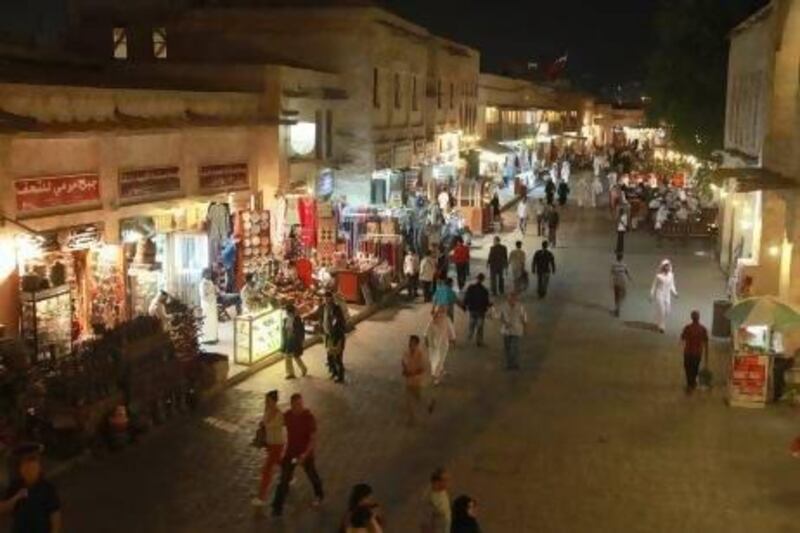Qatar's banks will need to follow the lead of the sector's largest lender, Qatar National Bank (QNB), and seek opportunities outside the country if they are to avoid being hit further by falling rates of growth and deposits at home.
With QNB growing full steam ahead through an acquisition spree that has transformed it into the Middle East's biggest bank, some of the country's regional ambitions are being realised.
But the rest of Qatar's banks are reporting falling earnings and raising capital as the competitive landscape proves more challenging than for the state-backed lender.
The country's transition from a gas-dominated economy to a frenzy of construction as it prepares to host the 2022 Fifa World Cup resulted in a sharp deceleration of economic growth.
Qatar's growth rate slowed from 14 per cent in 2011 to 6.3 per cent last year, according to the IMF.
Although most countries would love to be generating such a high rate of growth, banks and analysts agree that opportunities in the tiny country are becoming scarce.
Deutsche Bank has previously stated that Qatar's sharp deceleration could present significant challenges for the local economy, even if it is far from contracting.
"If going from 9 plus per cent growth down to 5-6 per cent growth in China is being considered as "hard landing" by some economists, our concern on Qatar is that going from circa 20 per cent down to 5-7 per cent - while still enviable for most sovereign states globally - could potentially have the same impact as the economists' concerns on China," the bank said in a statement. The investment bank feels there are no immediate signs of worry given the deep-pocketed government funds' ability to support the country's economy through what in Qatar may be described as relatively hard times.
Yet cracks are appearing elsewhere in Qatar's financial fuselage.
Qatar Islamic Bank reported net profits of 1.24 billion riyals (Dh1.26bn) for last year, reflecting a decline of 9.1 per cent compared with a year earlier.
The bank reported 502 million riyals set aside as provisions, more than double the 194.9m riyals booked a year earlier. Analysts said the bank's impairments in financial assets were the likely source of trouble.
Doha Bank has also shown signs of strain. Though its full year earnings rose by 5.1 per cent to 1.3bn riyals, it has begun a cash call to investors in an effort to improve its capital ratios.
The bank seeks to raise funds at a deeply discounted rate compared to its current market value through a share sale and offering of global depository receipts.
The lender is one of Qatar's most weakly capitalised, having struggled to grow its retail-focused banking business since the financial crisis hit in 2008.
For its part, QNB generated full-year net profit of 8.3bn riyals, growth of 11 per cent compared with 2011. That is in spite of four acquisitions during the year in Libya, Iraq, the UAE, and most recently Egypt.
Commercial Bank of Qatar has attempted to follow QNB's lead, having started talks to expand in Turkey via the purchase of a 75 per cent stake in Alternatifbank. CBQ reported net profits to 2bn riyals during 2012, a 6.7 per cent increase compared to a year earlier. "Credit demand has been dominated by the public sector with continuing low levels of demand from the private sector; however [CBQ] has successfully grown its lending and diversified revenue streams to deliver a record profit for the full year," said Abdullah Bin Khalifa Al Attiyah, the bank's chairman.
That may counteract the slowing pace of growth at home, where government firms have squeezed out many in the private sector. That was resulting in sluggish growth in deposits held with Qatari banks for most banks aside from QNB, said analysts. Deposits fell by 3.1 per cent across the sector during the third quarter, but Qatari banks' lending to each other has increased.
Stripping out the banking sector, deposits fell by $3.6bn to $28.9bn during the third quarter of the year, reflecting a drop of 10.9 per cent outside of financial firms, according to data from the Bank for International Settlements. With credit growth expected to remain strong, the deposit squeeze was likely to continue, resulting in Qatar banks turning increasingly to wholesale funding, according to analysts from Barclays Bank.
"There has been increased competition on attracting customer deposits, and this competition translates into higher costs paid on deposits," the analysts said in a statement.
"Credit growth is likely to remain strong (driven by expanding public sector spending) but to gradually slow down as funding tightens and reliance on wholesale funds increases."





